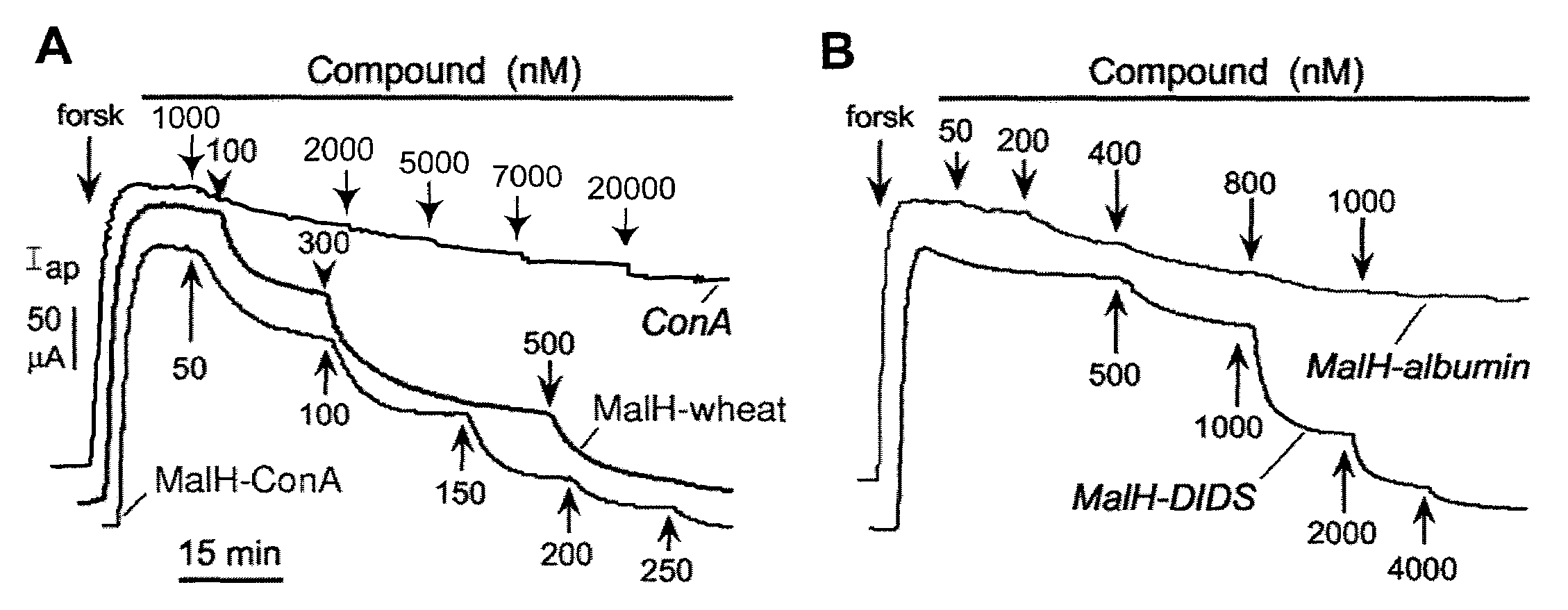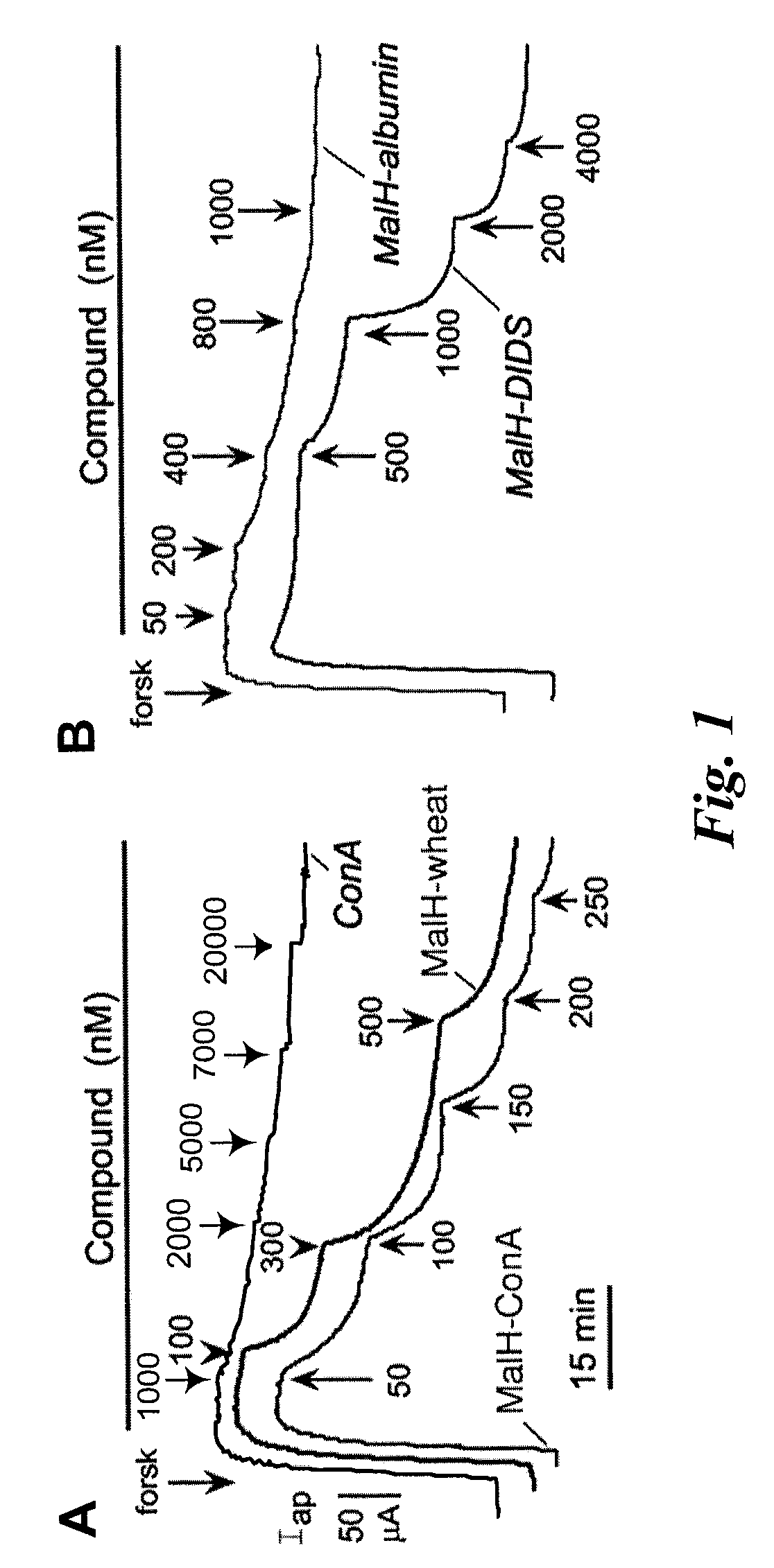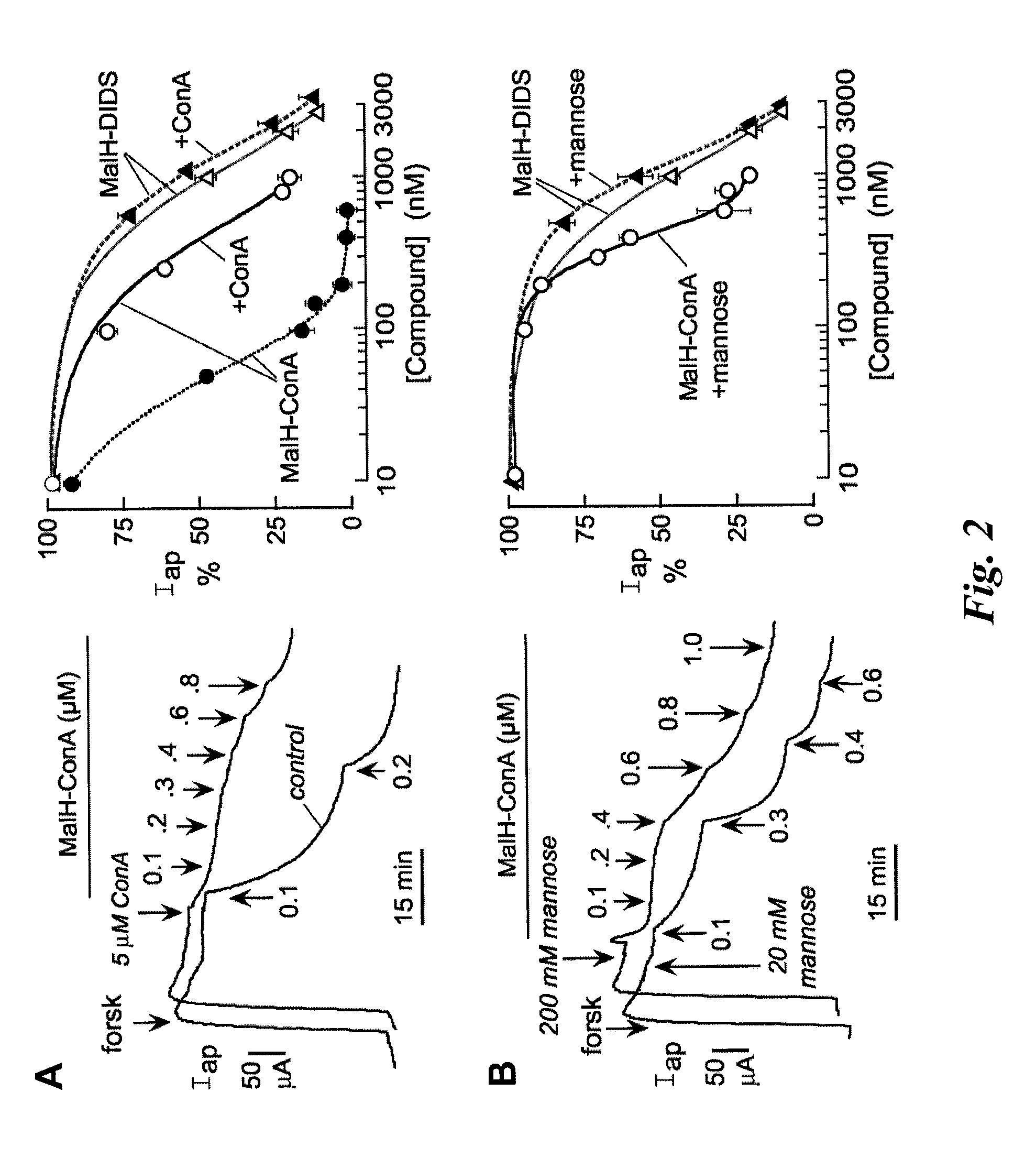Macromolecular conjugates of cystic fibrosis transmembrane conductance regulator protein inhibitors and uses therefor
a technology of transmembrane conductance regulator and protein inhibitor, which is applied in the direction of amine active ingredients, amide active ingredients, drug compositions, etc., can solve the problems of ineffective antibiotics for treating many pathogens, and achieve the effect of increasing intestinal fluid secretion
- Summary
- Abstract
- Description
- Claims
- Application Information
AI Technical Summary
Benefits of technology
Problems solved by technology
Method used
Image
Examples
example 1
Synthesis of a Lectin-Malonic Hydrazide Conjugate
[0203]A malonic acid hydrazide intermediate that is formed during the synthesis of highly polar malonic acid hydrazides (see Sonawane et al, FASEB J. 20:130-32 (2006)) was reacted with the homo-bifunctional crosslinker DIDS to yield the reactive CFTR inhibitor, MalH-DIDS. The DIDS linker is very polar and relatively rigid, which renders MalH-DIDS highly water soluble. MalH-DIDS was conjugated to several lectins (and to albumin as a control) in an alkaline carbonate buffer and then purified by gel filtration, affinity chromatography, and / or dialysis.
Synthesis of a Malonic Hydrazide Compound Linked to the Bifunctional Cross-Linker DIDS (4,4′-diisothiocyanatostilbene-2,2′-disulfonic acid)
[0204]2-naphthalenylamino-[(3,5-dibromo-2,4-dihydroxyphenyl)methylene]hydrazide [[[4-[2-(4-isothiocyanato-2-sulfophenyl)ethenyl]-2-sulfophenyl]amino]thioxomethyl]hydrazide-propanedioic acid, disodium salt (MalH-DIDS): A mixture of dihydrazide intermediat...
example 2
MalH-Lectin Conjugate Inhibits CFTR Transport Activity
[0209]This Example describes that the lectin moiety of a MalH-lectin conjugate binds to cell surface carbohydrates and that the conjugate inhibits the activity of CFTR.
[0210]Short-Circuit Current Measurements.
[0211]T84 (a human carcinoma line (colonic epithelial cells); American Type Culture Collection (ATCC), Manassas, Va.) and Fischer rat thyroid (FRT), epithelial cells that stably expressed human wildtype CFTR), were cultured on Snapwell filters with 1 cm2 surface area (Coming-Costar) to resistance>1,000 Ωcm2 as described (see, e.g., Muanprasat et al., J. Gen. Physiol. 124:125-37 (2004); Ma et al., J. Clin. Invest. 110:1651-58 (2002); Zegarra-Moran et al., Br. J. Pharmacol. 137:504-512 (2002)). Filters were mounted in an Easymount Chamber System (Physiologic Instruments, San Diego). When apical Cl− current measurements were determined in FRT cells, the basolateral hemichamber contained the following buffer: 130 mM NaCl, 2.7 mM...
example 3
Increased Potency of Small Molecule Compounds to Inhibit CFTR
[0213]This Example describes that the increased effectiveness of MalH-lectin conjugates to inhibit CFTR transport activity results from binding of the lectin moiety of a MalH-lectin conjugate to carbohydrate.
[0214]Carbohydrate binding to lectins is generally preserved following conjugation with various small molecules (see, e.g., Gunther et al., Proc. Natl. Acad. Sci. USA 70:1012 (1973); Gabor et al., Adv. Drug Deliv. Rev.; 56:459-80 (2004); Smart J. D., Adv. Drug Deliv. Rev. 56:481-89 (2004)). To show that the high CFTR inhibition potency of MalH-ConA was due to lectin-carbohydrate binding, competition studies using unconjugated ConA was performed. Short circuit current experiments were performed as described in Example 2. Addition of excess ConA (5 μM) greatly reduced the potency of subsequently added MalH-ConA. Representative apical membrane current data are shown in the left panel of FIG. 2A, and the average concentrat...
PUM
| Property | Measurement | Unit |
|---|---|---|
| pH | aaaaa | aaaaa |
| pH | aaaaa | aaaaa |
| membrane potentials | aaaaa | aaaaa |
Abstract
Description
Claims
Application Information
 Login to View More
Login to View More - R&D
- Intellectual Property
- Life Sciences
- Materials
- Tech Scout
- Unparalleled Data Quality
- Higher Quality Content
- 60% Fewer Hallucinations
Browse by: Latest US Patents, China's latest patents, Technical Efficacy Thesaurus, Application Domain, Technology Topic, Popular Technical Reports.
© 2025 PatSnap. All rights reserved.Legal|Privacy policy|Modern Slavery Act Transparency Statement|Sitemap|About US| Contact US: help@patsnap.com



